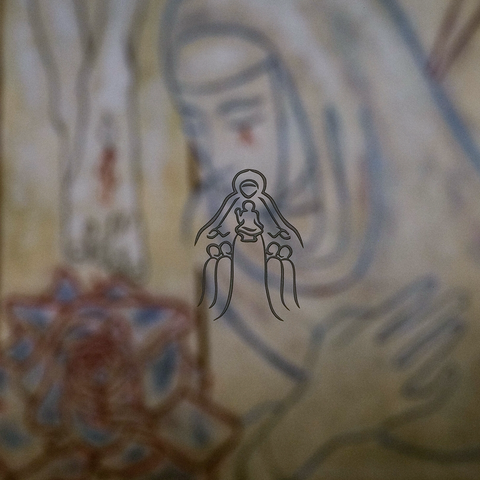In modern-day mass manufacture paint makers, gouaches have been known to be formulated using acrylic polymer emulsions and starch binders which alter the traditional texture to a more flexible dry paint film. In the face of such declining quality two artists, Rebecca Wallace and Pip Seymour, began making paints to their own tastes and recipes looking to emulate art materials from the past, with more variable grain and natural appearance.
With the above notes in mind, we are pleased to offer Pip and Rebecca's unique gouache formula which features the addition of a small oil to emulsify the pigment and lessen any chalky feel to the dried finish. Nevertheless these do not require any turpentine - they can and should be diluted with water only. On drying, the colour is fixed and permanent, and can be used on any art paper or gessoed panel.
Paintbrush Pairing and notes: because Goauche contains extra filler it tends to wear down soft hard brushes more than watercolour and thus sable brushes should be employed with care. Ox and horsehair, which are still soft but stronger are more well suited.
When the painting session is over, wash brushes carefully. Paint tends to get lodged in the base of the brush hair, where it meets the ferrule, which can cause the hairs to splay if not washed properly. Hanging paintbrushes upside down for drying can be helpful too to prevent this.
Pigments:
Vincenza white earth - A natural white earth pigment mined from a long standing working quarry in the Veneto region of northern Italy; largely made from clay deposits this is a soft, warm grey.
Provence ochre, palest - Ochre refers broadly to a pigment found worldwide, comprised from clay and/or sand which is tinted by the oxidisation of natural ferric (iron) present in the mineral. Paler shades contain more chalk; this particular pigment is mined from a working quarry in Provence in the south of France.
Puisaye Burgundy, yellow ochre - This darker shade of ochre, in comparison to the paler above, shows how the pigment varies according to source. Mined again from a French working quarry where it has been extracted for many centuries, the colour is a warm mustard yellow.
Puisaye Burgundy, apricot ochre - A rustier shade than its yellow counterpart this is another tonal variety of ochre mined at Puisaye. One of the oldest pigments in history, the more orange tones are familiar to cave paintings.
Puisaye Burgundy, red ochre - The darkest shade of ochre in this palette - red ochre is made with the common iron compound known as hematite which can be etymologically traced from the ancient greek haimatitēs lithos meaning “blood-red stone”.
Burnt sienna, Monte Amiata - taking its name from the city of its production during the Renaissance, Siena, this pigment was one of the first used by humans. This burnt sienna was mined in the 1970s, close to its Renaissance namesake at Bagnoli, a Tuscan village in the shadow of Monte Amiata - the quarry is long closed; this particular pigment is finite.
Porphyry crimson - mined from a working quarry, porphyry refers to the texture of igneous rocks that have a large grain crystal formations (such as quartz). Whilst more commonly used to refer to the purple-red form, this colour is a soft red-brown.
Porphyry violet grey - Similar to the above, this is a softer purple-grey tone; mined again in a working quarry that has been operating for centuries.
Terra Rosa ‘la vena’ - Literally the Italian for ‘red soil’ this pigment is comprised from a red clay produced by the weathering of limestone. This particular pigment is collected from the Sesti Vineyard in the south of Tuscany; the harvest of which is a byproduct of the wine industry.
Lapis lazuli sky blue - Traditionally known as ultramarine which literally translates to ‘across the sea’ - Lapis was first sourced from the valley of the Kokcha river in north-eastern Afghanistan. Used prolifically during the Renaissance, the mineral is still mined by hand.
Lapis lazuli extra deep - A darker shade of lapis than the above; the tonal difference is due to the different source/ quality of mineral as well as the processing of the raw material. The lapis used by Wallace Seymour is mined in cooperation with a working quarry.
Vivianite, blue ochre - Whilst pure Vivianite is colourless, it oxidises with ease and is known for its blue-green tone and has been used in painting in some capacity since the Roman times - mined here today in cooperation with a working quarry.
Honister green earth - Green Earth is a natural earth pigment that has existed since antiquity; its tone varies according to source. At Honister, in the lake district, you can find the last working slate mine in England - this soft grey-green is a byproduct of the mining industry there, otherwise destined for landfill.
Bohemian green earth - Sourced from the Czech Republic this is a darker shade of Green Earth where this shade has been mined for centuries in tradition.
Celadonite green - Celodine is of the Mica mineral group which is very commonly used in paint production; typically for more metallic and pearlescent tones this is a soft matte green with some nice granulation.
Helwith bridge grey slate - Mined from a historic working slate quarry in Helwith Bridge in the Yorkshire Dales.
Raw umber greenish - A dark green-grey, umber takes its name from Umbria, the central Italian region where this pigment was first mined for artistry. It is an ancient pigment which can have great tonal variation depending on the source.
Morellone violet Italian earth - an iron oxide pigment which washes towards a deep violet-purple. Mined from a traditional working quarry.








